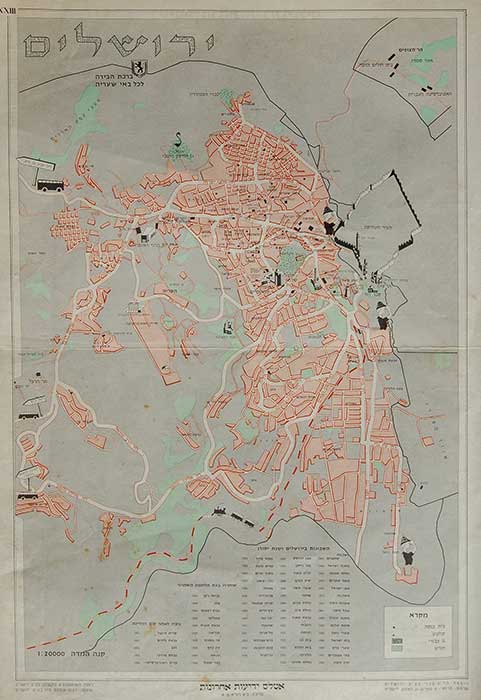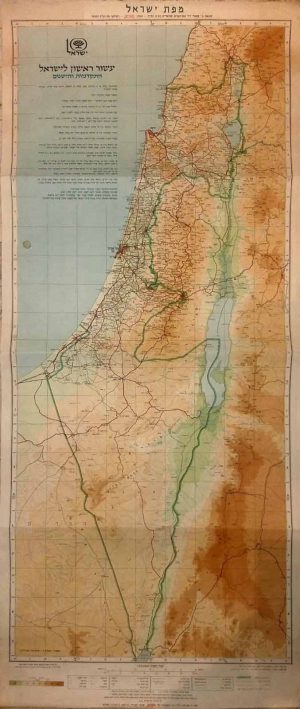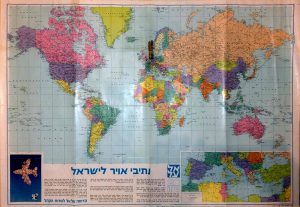Shop
Vintage Poster Israeli Map “The Old City of Jerusalem”
| Artist / Creator | |
|---|---|
| Technique | |
| Year | 1950 |
| Condition | |
| Size | 49×32 cm ~ 19×13 inch |
| A |
Description
Vintage Israeli Poster Map “The Old City of Jerusalem” 1950s
Printed in Jerusalem by KartaJerusalem (/dʒəˈruːsələm/; Hebrew: יְרוּשָׁלַיִם Yerushaláyim pronounced [jeruʃaˈlajim] ( listen); Arabic: القُدس al-Quds pronounced [ˈaːɫ ˈquːdsˤ] ( listen), Bait-ul-Muqaddas[3] (بيت المقدس), meaning “The Holy [City/Home]”),[i] located on a plateau in the Judean Mountains between the Mediterranean and the Dead Sea, is one of the oldest cities in the world. In the ancient cuneiform, Jerusalem was called “Urusalima”, meaning “City of Peace”, during the early Canaanite period (approximately 2400 BC).[4] It is considered holy to the three major Abrahamic religions—Judaism, Christianity and Islam. Israelis and Palestinians both claim Jerusalem as their capital, as Israel maintains its primary governmental institutions there and the State of Palestine ultimately foresees it as its seat of power; however, neither claim is widely recognized internationally. During its long history, Jerusalem has been destroyed at least twice, besieged 23 times, attacked 52 times, and captured and recaptured 44 times.[5] The part of Jerusalem called the City of David was settled in the 4th millennium BCE.[6] In 1538, walls were built around Jerusalem under Suleiman the Magnificent. Today those walls define the Old City, which has been traditionally divided into four quarters—known since the early 19th century as the Armenian, Christian, Jewish, and Muslim Quarters.[7] The Old City became a World Heritage Site in 1981, and is on the List of World Heritage in Danger.[8] Modern Jerusalem has grown far beyond the Old City’s boundaries. According to the Biblical tradition, King David conquered the city from the Jebusites and established it as the capital of the United Kingdom of Israel, and his son, King Solomon, commissioned the building of the First Temple. These foundational events, straddling the dawn of the 1st millennium BCE, assumed central symbolic importance for the Jewish people.[9] The sobriquet of holy city (עיר הקודש, transliterated ‘ir haqodesh) was probably attached to Jerusalem in post-exilic times.[10][11][12] The holiness of Jerusalem in Christianity, conserved in the Septuagint[13] which Christians adopted as their own authority,[14] was reinforced by the New Testament account of Jesus’s crucifixion there. In Sunni Islam, Jerusalem is the third-holiest city, after Mecca and Medina.[15][16] In Islamic tradition in 610 CE it became the first qibla, the focal point for Muslim prayer (salat),[17] and Muhammad made his Night Journey there ten years later, ascending to heaven where he speaks to God, according to the Quran.[18][19] As a result, despite having an area of only 0.9 square kilometres (0.35 sq mi),[20] the Old City is home to many sites of seminal religious importance, among them the Temple Mount and its Western Wall, the Church of the Holy Sepulchre, the Dome of the Rock, the Garden Tomb and al-Aqsa Mosque. Today, the status of Jerusalem remains one of the core issues in the Israeli–Palestinian conflict. During the 1948 Arab–Israeli War, West Jerusalem was among the areas captured and later annexed by Israel while East Jerusalem, including the Old City, was captured and later annexed by Jordan. Israel captured East Jerusalem from Jordan during the 1967 Six-Day War and subsequently annexed it into Jerusalem, together with additional surrounding territory.[viii] One of Israel’s Basic Laws, the 1980 Jerusalem Law, refers to Jerusalem as the country’s undivided capital. All branches of the Israeli government are located in Jerusalem, including the Knesset (Israel’s parliament), the residences of the Prime Minister and President, and the Supreme Court. Whilst the international community rejected the annexation as illegal and treats East Jerusalem as Palestinian territory occupied by Israel,[21][22][23][24] Israel has a stronger claim to sovereignty over West Jerusalem.[25][26] The international community does not recognize Jerusalem as Israel’s capital, and the city hosts no foreign embassies. Jerusalem is also home to some non-governmental Israeli institutions of national importance, such as the Hebrew University and the Israel Museum with its Shrine of the Book. In 2011, Jerusalem had a population of 801,000, of which Jews comprised 497,000 (62%), Muslims 281,000 (35%), Christians 14,000 (around 2%) and 9,000 (1%) were not classified by religion.[27]
Joshua was not present, as the biblical text states ‘no man shall come up with you’.[14] Later, Joshua was identified as one of the twelve spies sent by Moses to explore and report on the land of Canaan (Numbers 13:16-17), and only he and Caleb gave an encouraging report, a reward for which would be that only these two of their entire generation would enter the promised land (Numbers 14:22-24). According to Joshua 1:1-9, God appointed Joshua to succeed Moses as leader of the Israelites along with giving him a blessing of invincibility during his lifetime (Joshua 1:5).[15][16] The first part of the book of Joshua covers the period when he led the conquest of Canaan. Conquest of Canaan[edit] Main article: Book of Joshua Joshua Commanding the Sun to Stand Still upon Gibeon by John Martin At the Jordan River, the waters parted, as they had for Moses at the Red Sea. The first battle after the crossing of the Jordan was the Battle of Jericho. Joshua led the destruction of Jericho, then moved on to Ai, a small neighboring city to the west. However, they were defeated with thirty-six Israelite deaths. The defeat was attributed to Achan taking an “accursed thing” from Jericho; and was followed by Achan and his family and animals being stoned to death to restore God’s favor. Joshua then went to defeat Ai. The Israelites faced an alliance of Amorite kings from Jerusalem, Hebron, Jarmuth, Lachish, and Eglon. At Gibeon Joshua asked Yahweh to cause the sun and moon to stand still, so that he could finish the battle in daylight. This event is most notable because “There has been no day like it before or since, when the Lord heeded the voice of a man, for the Lord fought for Israel.” (Joshua 10:14) God also fought for the Israelites in this battle, for he hurled huge hailstones from the sky which killed more Canaanites than those which the Israelites slaughtered. From there on, Joshua was able to lead the Israelites to several victories, securing much of the land of Canaan. Death[edit] Joshua’s Tomb in Kifl Haris, April 2007 Joshua’s Tomb in Jordan When he was “old and well advanced in years”,[17] Joshua convened the elders and chiefs of the Israelites and exhorted them to have no fellowship with the native population, because it could lead them to be unfaithful to God.[18] At a general assembly of the clans at Shechem, he took leave of the people, admonishing them to be loyal to their God, who had been so mightily manifested in the midst of them. As a witness of their promise to serve God, Joshua set up a great stone under an oak by the sanctuary of God. Soon afterward he died, at the age of 110, and was buried at Timnath Serah, in the hill country of Ephraim, north of Mount Gaash.[19]


 Vintage Israeli Poster Map "Israel's independence through the ages" 1950s
Vintage Israeli Poster Map "Israel's independence through the ages" 1950s




